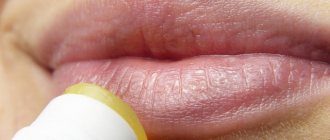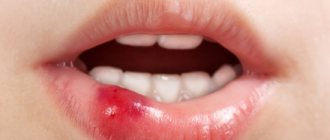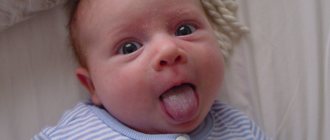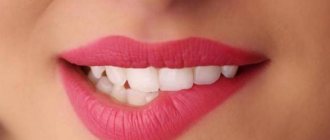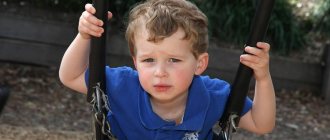Often babies suck their fists, fingers, lower lip, and this should not cause concern if the baby is an infant.
But if a child is over a year old and continues to suck his lip, then this is already a bad habit.
Some mothers are seriously concerned about this problem and want to know how harmful it is, how to wean a child from sucking the lower lip, and is it worth doing it? Let's consider this issue in detail.
This is the norm
Every young mother is concerned about the question of why her child sucks his lower lip. First of all, the parents’ task is to determine when he does this and what is associated with such an action. It is absolutely normal if the baby begins to grab his lip when he feels hungry. This happens when he is still very small, he does not know how to speak, with such a gesture he shows an adult that it is time to refresh himself. It is absolutely normal for a child to suck his lower lip when he is thirsty. His oral cavity begins to dry out, with such movements he tries to eliminate the feeling of discomfort.
The baby screams, makes trouble, offends others
If the baby regularly makes scandals, this may indicate that the baby is hiding some serious problem. A little person in constant stress must throw out negative emotions, and he does this in the best way he knows how: he throws toys, hits and bites his mother, takes away the car from the neighbor boy. This behavior is often typical for children raised by one parent or grandparents.
The most amazing thing is that aggressive children can hear encouraging words from adults: “You are my best child,” “I adore you,” “You are my only hope in life.” The baby feels a serious burden of responsibility, because his parents consider him ideal, so he needs to live up to it. The nervous tension that grows inside every day does not give the child peace, and he has to use aggression to free himself from negative emotions.
These are teeth
If a child at 5 months is sucking his lower lip, then perhaps this behavior is associated with teething. It is worth paying attention to the presence of accompanying symptoms, which include:
- increase in body temperature to 37.5-38 degrees;
- the appearance of obvious swelling in the gum area;
- increased salivation;
- Many children develop snot or nasal congestion at the same time they start teething.
If the baby behaves as usual, then there is no need to take any measures. It's worth being patient. As soon as the teeth come out, the baby will disappear this habit. If a child is constantly naughty, it is necessary to relieve pain with a cooling gel or painkiller.
It's stress
If a child at 3 months sucks his lower lip, then this can also be considered normal. By this time, the baby is already accustomed to feeding from the breast or formula from a bottle, thus he repeats the reflex that is familiar to him.
Many pediatricians say that if a child sucks his lower lip at 3-4 months, this may be associated with feelings of fear and stress. If he is separated from his mother, then in this way he tries to calm himself down. But he stops doing such actions as soon as he finds himself in the arms of a caring parent.
It is worth noting that in children these habits go away on their own; they do not require any treatment or visits to a psychologist. You just have to be patient; in a few weeks the baby will forget about this habit.
Neurological development of a child in the first year of life. Inspection "Fundamental"
Salmagambetova Elena Garrievna
Neurologist, Epileptologist
April 24, 2021
The development of a child in the first year of life occurs within a certain time frame. By the second month of life, your baby holds his head well, follows the object, walks, smiles; at 3-3.5 months – rolls over onto its side; at 4.5-5 – turns from back to stomach, takes toys; at 7 months - sits, crawls from 8, at 10-11 - stands on a support and begins to walk independently until one and a half years.
In general, according to generally accepted ideas, the absence of developmental delay is an important indicator of health. But it also happens that with relatively good psychomotor development, some disturbances in the overall harmony of movements arise, “discomfort”, which alarms attentive parents. The range of complaints is very wide - from a persistent tilt of the head to one side from 1.5-2 months to significant asymmetry in movements, gait disturbances after a year. Of course, gross anomalies are detected already in the maternity hospital. For example, congenital muscular torticollis, damage to the nerves of the brachial plexus (the baby’s arm is “flaccid”, straightened in all joints, brought to the body), congenital deformation of the feet, etc.
Many other diseases of the neuromotor system are typically diagnosed during the first year of life, usually with close collaboration between a neurologist and an orthopedic surgeon. Therefore, now they are even trying to distinguish neuroorthopedics as an independent field in medicine.
Early recognition of neuro-orthopedic problems, disorders in the development of bones and joint functions is very important, since as the child grows and develops, the manifestation of these conditions may intensify and, accordingly, more therapeutic measures will be required to cope with the disease.
The first examination takes place, on average, from 1.5 to 3 months. This inspection is “fundamental.” Information about the course of pregnancy and childbirth is carefully collected, complaints are assessed, the child is examined (don’t be surprised that the examination itself does not take much time - here the duration can tire the child and depress his responses). If there are suspicions of disturbances in the motor sphere, then during a subsequent examination (for example, after 1 month) the most important thing is to understand whether these signs are worsening. In addition, additional instrumental diagnostic methods often help us - ultrasound of the cervical spine and brain, ultrasound of the hip joints, radiography (according to strict indications), electroneuromyographic study (analysis of the activity of muscle and nerve fibers). But I repeat once again that many anomalies of body shape and movement functions in a small child are diagnosed clearly and definitively by comparison in dynamics.
Let's focus on the main points: “what to pay attention to?” (frequently asked by parents). It is very difficult to give an answer in a simple form, but to make it clear, let it sound like this:
- body position
- range of motion
- the presence of asymmetry in the motor sphere.
I will give examples.
When the baby lies on his back, his head is preferably turned to one side (forced position?) Normally, the head changes alternately in relation to the midline of the body, and may be slightly bent towards the chest.
The baby's shoulders are symmetrical on both sides. In a child under 3 months of age, the forearms may be slightly bent and the hands clenched into fists; this is normal. But if, when pulling yourself up by the handles, you can feel a weakening of flexion on both sides or a decrease in muscle strength on one side, this is no longer the norm.
We also pay attention to the child’s legs - are they strongly bent at the hip and knee joints, is there strong resistance when changing clothes, swaddling, or vice versa - lethargy, weakness, “hyperextension” are noted.
Now the baby begins to roll over and constantly on one side (as if he is sparing the other half of the body). Takes toys more boldly and clearly with one hand (the other “lags behind”). This is especially noticeable after 5.5 – 6 months.
Many people know the “fencing pose” (the dependence of muscle tone on turning the head) - one arm is extended and raised closer to the face, while the other is bent; the difference in the legs is weaker, but still there. Normally, this reflex disappears between 4 and 6 months of life. Its long-term preservation is beyond the norm.
When the baby lies on his stomach - at 4 months, the upper part of the body rests on the forearms and open palms, the legs are extended at the hip joints and bent at the knee joints. By 6 months, the legs are already fully extended. In pathology, these time frames are significantly disrupted.
If an infant is placed vertically, supported by the “armpits,” then at 4-5-6 months the legs can be straightened, and the child “stands” on his toes. But by the end of the 6-7th month the child is already resting on his entire foot. If there is hyperextension of the lower extremities with significant adduction, the ability to “stand” on the tips of the fingers remains after 8 months - these are symptoms of the disease.
The child is sitting, but we see that this requires a lot of tension in the extensor muscles - we are alarmed by this position.
The reaction “readiness to jump” looks very vivid (or the reaction “paratrooper reaction” - I read it in one German training manual). This is also the support reaction of the upper limbs.
An adult holds the child by the hips and allows the upper body to “fall” forward. The child “falls” onto outstretched arms, in most cases with open palms. Normal, checking this by 10-11 months.
You can list a lot in detail, but the main thing you need to understand is the reactions of holding the body, balance reactions, clear, purposeful movements, which must be formed in a certain sequence.
And now comes the child’s main achievement - he went! Not only did his skeleton and muscles become stronger, but his mind also matured, and there was a need to expand the boundaries of his “horizon.” When he walks 20-30 meters on his own, without support, we evaluate the gait and if everything is fine, we do not limit the need to walk, run, climb, not forgetting about constant sensitive control (injury prevention).
In the future, a healthy baby will need examinations by a neurologist and an orthopedist more than once a year.
He now has to master complex motor skills, in many ways consciously learning the beauty and dexterity of movements.
This is not the norm
But it is absolutely not the norm if a child sucks his lower lip at the age of 1 year. In this case, such behavior may signal problems:
- Feeling of discomfort. Perhaps the child has something hurting, for example a tooth, or stomatitis has formed under the lip.
- Overexertion and severe stress. This manner of behavior is typical of irritable and unbalanced people who, through this habit, also try to calm themselves down.
- The most dangerous situation is when the child simultaneously licks his lips and freezes, tenses, rolls his eyes, and makes monotonous intermittent movements of his limbs. This may be due to neurological diseases.
Of course, it is worth observing the frequency of such behavior. If a child licks his lip once or does it after every meal, then this should not be taken into account. But you need to be wary if he does this constantly or affects the lip so actively that swelling or blood stains appear on it.
What to do?
What to do if the child is already quite large and sucks his lower lip. There are several reasons for this behavior. First of all, the parent must figure out what’s going on. This requires:
- Talk to him, find out the reason why he does this.
- Find out why he begins to behave strangely, perhaps he does this every time after his parent punishes him.
- Examine his oral cavity independently for the presence of stomatitis or the eruption of new teeth. If, as a result of the examination, white plaque was discovered, then it is worth treating the affected area with a special dental gel.
- Show the child to a specialist: psychologist or neurologist.
The way to solve a problem directly depends on the cause of its occurrence. But under no circumstances should you:
- scold the child every time he performs this action;
- try to shame him.
In this case, the child may withdraw into himself even more or begin to do this on purpose to annoy the parent. But you shouldn’t let such a habit take its course either; it can lead to even more global problems.
Why do older children suck their fingers?
Usually the psychological component comes to the fore here. Sucking has a calming effect on the child, so the child entertains himself if he is bored, consoles himself if he is upset, or lulls himself to sleep when he wants to sleep. The baby can use this as a “retreat into infancy” when he cannot cope with the situation or get what he wants. Typically, thumb sucking continues in those babies who have done it up to a year, less often it occurs again after a year. The first thing to do when your baby is thumb sucking is to think about what might be bothering the baby. Maybe a move, kindergarten or parental quarrels, the appearance of a younger child, or something else worries him. If the cause is eliminated, the habit usually disappears. If thumb sucking occurs only occasionally, and most of the time the child is cheerful, sociable and calm, there is no reason to worry.
Just explain to your baby that the finger needs to be taken out of the mouth. But if the baby almost constantly has a finger in his mouth and this replaces even games for him, parents should think about why the child almost constantly calms himself down, what this is connected with and how to help him with this.
The child is bored without the company of his peers, perhaps he has few suitable toys, he moves little or sits in the stroller a lot. The baby may be angry or offended by you for punishing him or forbidding him to do something interesting to him. Then the best way to help is to distract his attention with something exciting (a new game, a bright book) or just chat, hug and caress him. Children who are too shy suck their thumb when they are afraid or hesitant to take a step towards their peers or unfamiliar adults.
How can we help? First of all, talk to a psychologist or independently assess the baby’s condition. Are there any traumatic or worrying situations for him? Encourage him more often for not sucking his thumb for an hour or two, and in no case scold him for forgetting. Simply gently remove your hand from your mouth and distract your child with a game or new activity. Don't let him get bored. Don't be angry with the baby, it will worry him and will only worsen the problem.
Possible complications
As mentioned earlier, if a child sucks his lip in infancy, then this is an absolutely normal phenomenon that will pass over time. But measures should be taken if the bad habit continues to persist at the age of one year or later.
If it is not eliminated in time, there is a risk of a number of complications, namely:
- Changes in the structure of the upper teeth. Over time, they will begin to deform and bend towards the lower lip.
- A gap will appear between the upper and lower rows of teeth, which can only be eliminated through surgery or long-term wearing of dental structures.
- Swelling of the lower lip will form; visually it will be noticeably different from the upper lip and, naturally, will be noticeable to others. In the future, it will be quite difficult to get rid of such a cosmetic defect.
- If the problem is seriously missed, the malocclusion will become so obvious that a gap will appear not only between the upper and lower teeth, but also between the lips.
- The risk of bacteria entering the oral cavity will increase, which may cause stomach pain and diarrhea.
- As a result of constant sucking, saliva will be actively produced, and due to prolonged contact with the skin, it will begin to become irritated in the area of the cheeks and chin.
In order to prevent the development of complications, you should promptly pay attention to the child’s distinctive behavior, identify its cause, visit a competent specialist and adhere to the treatment measures prescribed by him.
Negative points
If lip sucking becomes a bad habit, it can lead to negative consequences:
- pathogenic bacteria and infections will freely penetrate into the oral cavity. The child may develop dysbacteriosis, colic, constipation or, conversely, loose stools;
- also, with constant sucking, the oral mucosa is overstimulated, a large amount of saliva is released, as a result of which irritation and sores begin to appear on the lips and cheeks, which can be accompanied by a third-party infection;
- development of malocclusion and deformation of the dentoalveolar apparatus, while the upper jaw begins to protrude.
Treatment
If the problem is neurological in nature, the neurologist will usually prescribe sedatives or anticonvulsants. If the problem is dental in nature, the dentist may prescribe an anesthetic or antibacterial gel. But, if such behavior is not associated with a disease, but is a bad habit, then the mother should take care of how to wean her child from sucking the lower lip, adhering to psychological advice:
- First of all, you should show the child how ugly it looks from the outside. Perhaps he will see this behavior, he will not like how it looks, and he will try not to repeat these actions again.
- You can come up with a reward system, for example, if the child does not do this for one week, then the parent takes him to an amusement park. At first he will try not to suck his lip out of curiosity, and then this habit will disappear.
- You can also lubricate your lips with something sharp, such as mustard or aloe juice. But do not overdo it with this component, as skin irritation or problems with the gastrointestinal tract may occur.
- If your child is between 6 and 18 months old, you can give him a pacifier.
When a child is busy with his own business and constantly sucks his lip, then you should be wary and observe his further behavior. This may be a bad habit that leads to various complications, or a symptom of a serious illness that requires immediate treatment.
Advice from psychologists
The habit of lip sucking causes great concern among parents, especially if it is accompanied by sucking on clothes, corners of blankets and fiddling with seams. Many mothers cannot wean their baby off a bad habit on their own and turn to specialists.
Child psychologists give the following recommendations:
- You cannot reproach, scold or shame a child for sucking and biting his lips. This can only make the situation worse;
- it is necessary to find out the cause of increased anxiety;
- parents should analyze their emotional state, because children are a reflection of our inner world;
- if the child attends kindergarten, be present with him for 1-2 days to understand what causes his anxiety;
- protect your baby from family conflicts and nervous conditions;
- conduct play and sand therapy;
- give him as much attention as possible;
- limit watching TV and playing on the computer or phone, without infringing on the child’s interests;
- in difficult cases, contact a child psychologist who will work with the child and parents separately.
Sometimes, after weaning off the habit, the child starts sucking his lip again after some time. In this case, parents should conduct a careful analysis of the time during which he did not suck his lip.
It is necessary to understand why the habit returned, what influenced it and change the situation.
In order for a child to stop biting his lip, parents must find out the cause and make every effort to eliminate it. In a comfortable environment and surrounded by loving loved ones, the baby will forget about the bad habit.
